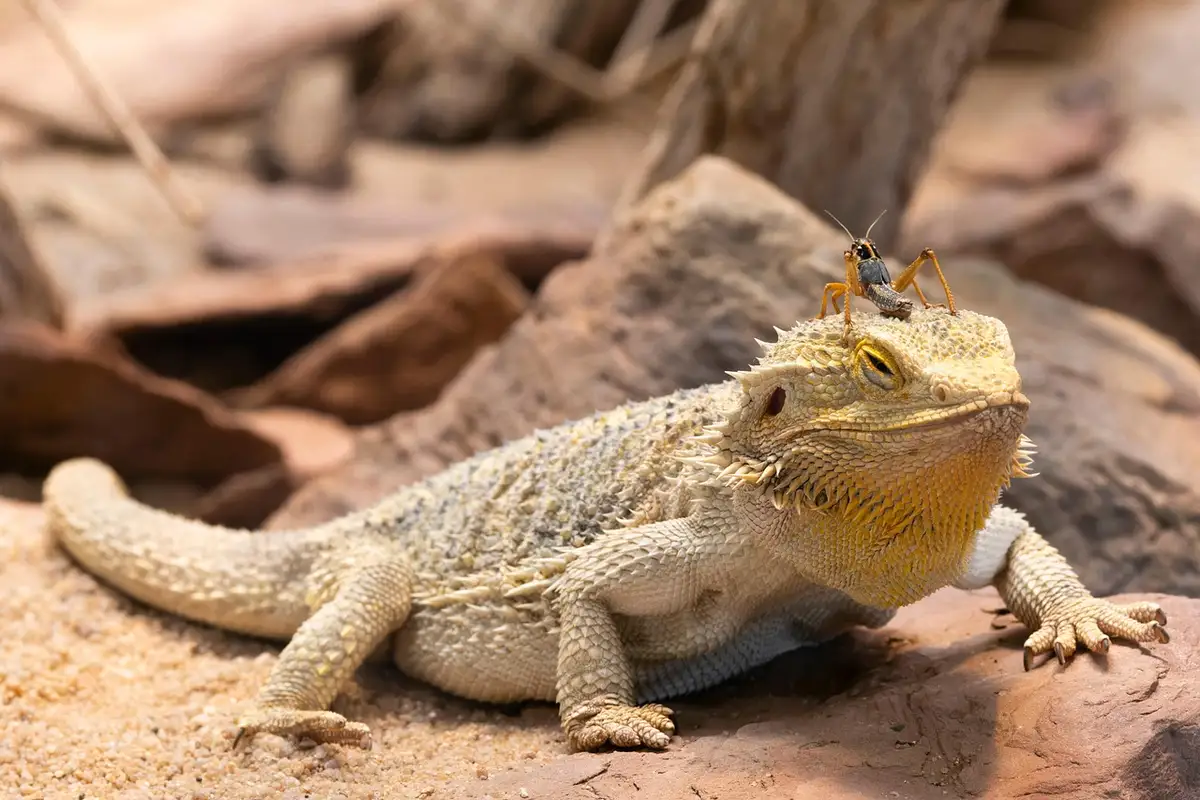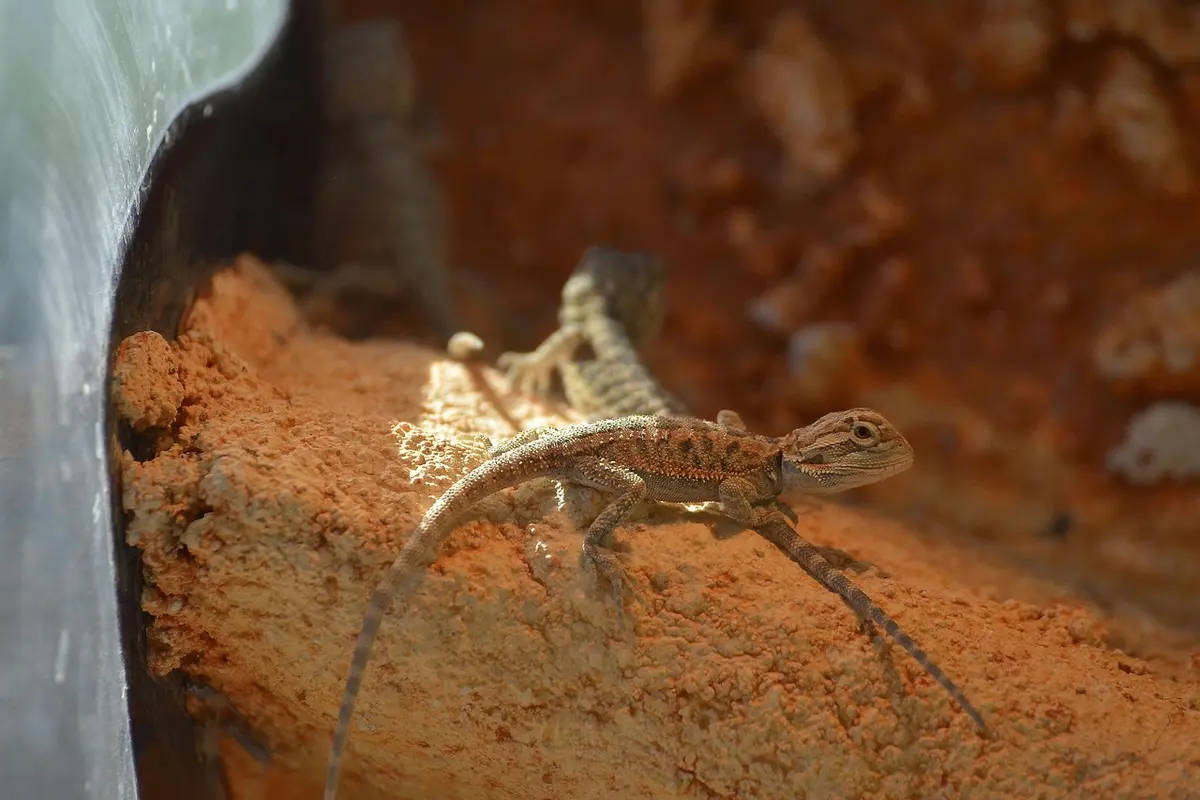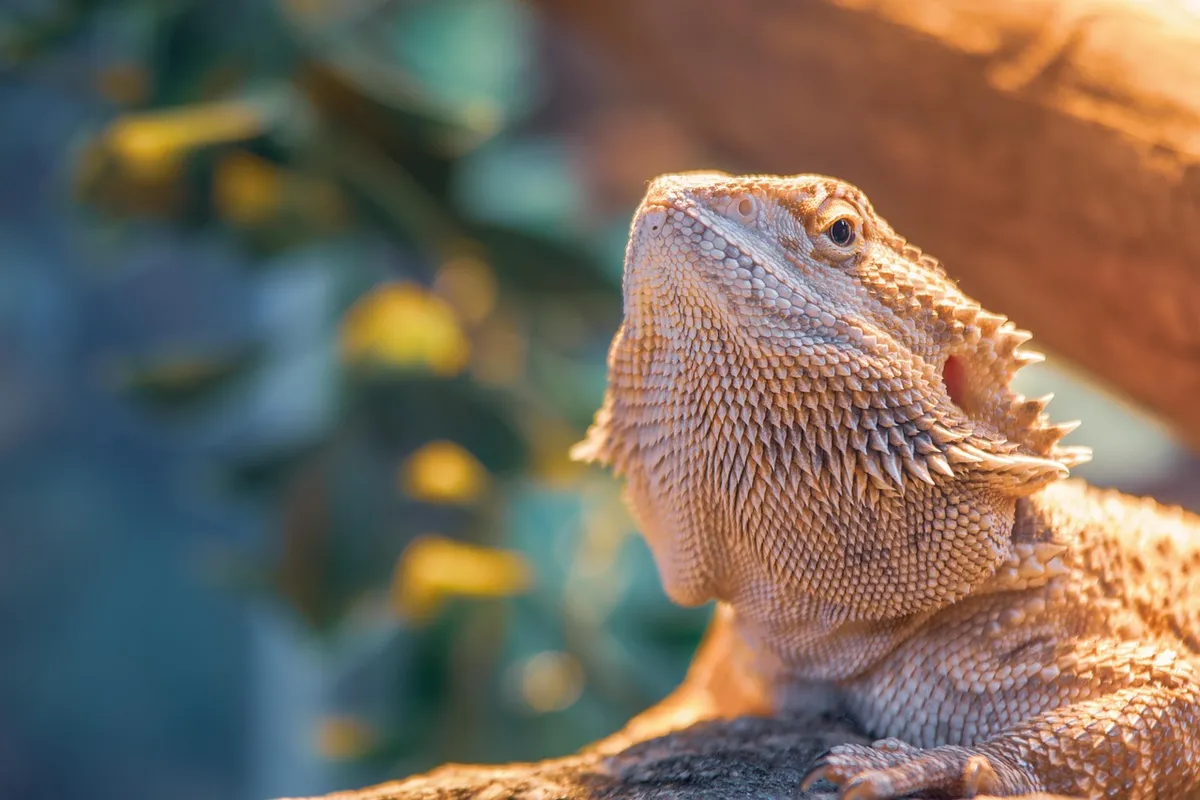Can Multiple Bearded Dragons Live Together? The Honest Guide
Published on: November 18, 2025 | Last Updated: November 18, 2025
Written By: Beardie Joe
You’re probably asking yourself if you can house two or more bearded dragons in one tank, hoping they’ll become best friends.
As a long-time owner of several bearded dragons, I’ve learned through both success and heartache what truly works for their well-being.
We’ll explore the serious risks of co-habitation, the rare situations where it might be safe, and the better, kinder alternatives I recommend for your pets.
Understanding Bearded Dragon Social Behavior
In the vast, sun-baked Australian outback, a wild bearded dragon leads a solitary life. They are not pack animals. An adult dragon will claim a territory and defend it fiercely from other dragons. They do not get lonely; their world revolves around finding food, basking, and avoiding predators, not socializing. Bearded dragons in the wild eat a varied mix of insects and greens. For pets, a complete feeding guide helps ensure balanced nutrition that mirrors this natural diet. I’ve observed my own dragons for years, and their indifference to each other outside of breeding contexts is profound.
One of the biggest myths I hear is that a solo dragon is a sad dragon, or that keeping a pair is “cuter.” This is a human emotion projected onto a reptile. Providing a companion does not fulfill a social need for them; it creates a competitor for resources. Another common misconception is that two females will be fine together. While sometimes less volatile than male-female or male-male pairings, it is never without risk. They are still hardwired for solitude.
Learning to read your dragon’s body language is your most important tool. In a group setting, a content dragon is simply… indifferent. They ignore the other. A stressed dragon sends clear signals: Just as you can tell when a dragon is healthy or sick, you can learn to recognize stress indicators. For example:
Key Risks of Bearded Dragon Cohabitation
The decision to house dragons together introduces a host of potential problems that can turn serious very quickly. The primary risk is injury, plain and simple. These are not minor squabbles; they are conflicts over the most basic needs for survival.
- Territorial Aggression: The dominant dragon will claim the best basking spot, the prime hide, and the entire enclosure as its own. The submissive dragon is denied these essential resources.
- Feeding Competition: The boldest dragon will eat first and eat most. The shy one misses out, leading to malnutrition and failure to thrive, even if you think you’re feeding enough.
- Bite Injuries: Fights can result in missing toes, tail tips, and severe lacerations. I’ve treated a dragon that lost part of its tail to a cage mate; the wound became infected and required vet care.
- Chronic Stress: Constant low-grade stress from living with a competitor weakens their immune system, making them susceptible to illness. A stressed dragon is an unhealthy dragon.
- Disease Transmission: If one dragon carries a parasite or virus, it will almost certainly spread to the other. You are effectively doubling your vet bills and heartache.
I learned my lesson early on. I temporarily housed a younger dragon with an older, established one. The older dragon seemed fine, but the younger one stopped eating and became lethargic. The stress of the living situation suppressed his appetite and immune system, leading to a costly parasite outbreak. If your bearded dragon isn’t eating, it can signal stress or illness and deserves a quick check of lighting, temperature, and companionship; there are practical solutions to try. Separating them was the only solution. The younger one recovered in his own quiet space, and the older one seemed visibly more relaxed with his territory back. Their welfare must always come first.
Enclosure Setup for Multiple Bearded Dragons

If you’re even considering housing more than one bearded dragon, their living space becomes your absolute top priority. I learned this the hard way early on. A cramped tank is a pressure cooker for stress and aggression, turning a peaceful habitat into a battlefield. Proper bearded dragon terrarium size requirements and setup are the next crucial steps to get right. A well-planned enclosure supports heat, UVB, and room to stretch, reducing tension.
Essential Equipment and Spatial Needs
Forget the minimums you see for single dragons; cohabitation requires a palace, not a prison. Here’s a quick comparison of what you’ll realistically need:
- Two Dragons: An absolute minimum of a 125-gallon tank, though I strongly advocate for a 4x2x2 foot enclosure as a starting point.
- Three or More Dragons: You are now in custom-built enclosure territory. Think 6 feet wide or larger. I use a 6x2x2 for my trio of females, and even that requires constant vigilance.
Beyond sheer square footage, you need must-have items to de-escalate tension before it starts:
- Multiple, Identical Basking Spots: Place these at opposite ends of the enclosure. This prevents one dragon from monopolizing the “best” heat and UVB.
- Multiple Food and Water Dishes: Again, place these far apart to stop resource guarding.
- Linear UVB Tubes, Not Compact Bulbs: You need a UVB gradient that spans the enclosure so every dragon can soak up rays without fighting for a single spot.
The goal is to create a complete environment where they can avoid each other entirely if they want to. Your setup should offer duplicate resources in different locations to eliminate competition.
Creating Multiple Hides and Escape Routes
Bearded dragons need to feel secure, and that means having options to get out of sight. Bearded dragons can jump, so consider their jump height and distance when designing a safe landscape. Follow these steps to create a safe landscape:
- Provide at least three hides per dragon. This sounds like a lot, but it’s crucial. Use a mix of commercial hides, cork bark rounds, and rock caves.
- Place hides in every temperature zone. Have a warm hide near the basking spot, a cool hide on the opposite end, and one in the middle. No dragon should have to choose between safety and thermoregulation.
- Create visual barriers with décor. Use sturdy branches, artificial plants, and stacked flat rocks to break up the line of sight across the tank. This stops constant staring, which is a common stressor.
- Ensure all hides have multiple exits. A hide with only one entrance can become a trap. I always use half-log hides or position rocks to create a back door for a quick getaway.
Gender Dynamics in Group Housing
This is where things get really tricky, and where most cohabitation attempts fail. The gender combination you choose is the single biggest predictor of success or disaster.
- Male-Male Pairing: This is a firm and absolute no. I will never attempt this again after seeing the relentless aggression. Males are hardwired to fight for dominance, leading to severe injury or death.
- Female-Female Pairing: This is the only combination I cautiously recommend for experienced keepers. While less violently territorial than males, a hierarchy will still form. You must watch for subtle bullying over food and basking spots.
- Mixed Male-Female Pairing: This is often misunderstood. You might think it’s natural, but it’s incredibly risky. The male will relentlessly pursue the female to breed, causing her immense stress, physical injury, and nutrient depletion from constant egg-laying.
Breeding is a major risk in any mixed-gender setup. You must be prepared to manage a constant cycle of eggs, which requires specialized incubators and a plan for dozens of baby dragons. This is not a casual endeavor.
Accurate sexing is your first and most important step. Don’t guess. Wait until your dragons are at least 5-6 inches long. The two most reliable methods are looking for two hemipenal bulges at the base of the tail (males) or a single, central bulge (females), and using a flashlight to see the presence of hemipenes through the tail (the “transillumination” method). When in doubt, ask a vet. For a full, step-by-step guide on determining bearded dragon gender, see our complete guide. It covers each method, age considerations, and how to interpret results.
Female Bearded Dragon Cohabitation
From my experience, housing females together is the only scenario with a chance of working, and it’s still not a guarantee. They need more space than you think.
- Watch for specific behavioral cues like persistent arm-waving (a submissive gesture) from one dragon, or one consistently blocking another from the basking spot.
- Even without overt biting, the stress of a low-ranking dragon can suppress her appetite and weaken her immune system over time.
- The aggression risk is lower than with males, but the potential for chronic stress is very real and just as dangerous.
Male Bearded Dragon Cohabitation
I want to be perfectly clear on this point. Do not house male bearded dragons together. Ever.
- Their territorial aggression is extreme. It’s not a matter of “if” they will fight, but “when.”
- This fighting includes vicious biting, tail whipping, and head bobbing contests that prevent the submissive male from accessing food, heat, and UVB.
- The result is always the same: one dominant, healthy dragon and one injured, stressed, and starving dragon. The only ethical choice is to house them separately from the start.
Health and Behavior Monitoring

Living with a roommate you didn’t choose is stressful, and your dragons will tell you all about it-if you know how to listen. You must become a dedicated observer, watching for the subtle signs that tell the real story of their cohabitation. I spend the first ten minutes of my morning just watching my dragons’ morning routines before I even offer them food.
Daily Checkpoints for Stress, Injury, or Illness
Make this a ritual, like brushing your teeth. A quick glance isn’t enough. Look for these specific things every single day:
- Body Language: Black, stress-marked beards are a giant red flag. So is frantic glass surfing, which signals a desperate desire to escape.
- Appetite Changes: Is one dragon eating voraciously while the other hides and refuses food? The submissive one is likely too stressed to eat.
- Basking Spots: Does one dragon always control the prime basking area, preventing the other from warming up properly? This is a common power move.
- Physical Condition: Run your eyes over their bodies. Look for fresh scratches, bite marks on limbs or tails, or missing scales. Check for tail or toe nips.
- Sleeping Positions: Are they always piled on top of each other? This isn’t cuddling. It’s one dragon dominating the best spot and smothering the other.
Quarantine Procedures for New Tank Mates
I cannot stress this enough. Skipping quarantine is like playing Russian roulette with your entire reptile family’s health.
- Isolate Completely: The new dragon must live in a separate enclosure, in a different room if possible, for a minimum of 30 days. No shared airspace initially.
- Dedicate Equipment: Use separate, non-shared tools for feeding, cleaning, and handling. This prevents cross-contamination of parasites or bacteria.
- Monitor Health: During this period, watch the new dragon’s eating habits, stool quality, and energy levels. A vet check and fecal exam are highly recommended.
- Wash Your Hands: Always, always wash and sanitize your hands between handling the quarantined animal and your established pets.
Steps for Safe Separation if Conflicts Arise
If you see any serious signs of bullying or stress, you must act immediately. Waiting even one more day can result in severe injury or a dead dragon.
- Act Fast: Do not hesitate. The moment you see consistent aggression or injury, the experiment is over.
- Prepare a Backup Enclosure: You should always have a spare tank or large plastic tub set up and ready to go for exactly this scenario.
- Separate Gently: Carefully remove the bullied or submissive dragon first and place it into the new, calm environment.
- Do Not Reunite: Once separated, they must remain separated permanently. The stress dynamic will not magically disappear.
Making the Cohabitation Decision

This is the moment of truth. You have the information; now you have to make a choice that prioritizes your animals’ lives over your own desires.
Weigh Animal Welfare Priorities Over Convenience
It is not easier or cheaper to house two dragons together. You will need a massive, custom-built enclosure, double the vet fund, and constant vigilance. Ask yourself this hard question: am I doing this for them, or for the aesthetic appeal of a single, impressive tank? Their quality of life must be the only factor that matters.
Suggest Alternatives Like Visual-Only Contact
If you love the idea of your dragons “hanging out,” there are much safer ways to achieve this. Visual contact can satisfy your desire for a shared experience without the risks of physical cohabitation.
- Place two separate enclosures side-by-side so they can see each other.
- Allow for supervised “floor time” where they can explore a neutral space under your watchful eye, ready to intervene at the first sign of tension.
- This setup lets them be neighbors without being roommates, eliminating competition for food and heat.
Share Personal Experience With Successful and Failed Setups
I learned this lesson the hard way. My first attempt was with two brothers from the same clutch. For six months, it seemed to work. They basked near each other and never fought. Then, one morning, I found the smaller one with a severely nipped tail and a terrified posture. He had lost weight I hadn’t even noticed. My failure to see the slow-burn stress almost cost him his life. If your bearded dragon won’t eat, check the basics first. Temperature and lighting must be right, and watch for stress signals. He recovered in his own tank and blossomed into a completely different, more confident dragon.
My “successful” setup isn’t cohabitation at all. I have two large tanks next to each other. They see each other daily, sometimes head-bob in what I assume is lizard conversation, and live completely stress-free, healthy lives in their own sovereign territories. This is the only scenario I have ever seen work long-term, and it’s because they aren’t actually living together.
Frequently Asked Questions
Why can’t bearded dragons live together?
Bearded dragons are solitary, territorial animals that naturally compete for resources, leading to aggression, stress, and potential injury when housed together. Understanding how morph variations can influence behavior and care is helpful, and our species morph identification guide outlines these differences.
Can two female bearded dragons live together?
While female pairings are less volatile than males, they still risk establishing a hierarchy with bullying and chronic stress, requiring a large, well-equipped enclosure and constant monitoring.
How many bearded dragons can live together?
It’s not recommended, but if attempted, only two females might cohabitate in a spacious, custom-built enclosure with duplicate basking spots, hides, and food dishes to minimize conflict.
Final Verdict
After years of caring for these wonderful reptiles, my lived experience and the collective wisdom of the community point to one clear answer. I strongly advise against housing multiple bearded dragons together. The risks of stress, injury, and resource competition are simply too high for what is, by nature, a solitary animal. When comparing male vs female bearded dragons, size and temperament often guide care decisions. Males are typically larger and more territorial, while females are commonly smaller and calmer.
While some experienced keepers might manage a temporary breeding scenario, this is the rare exception, not the rule. Providing each dragon with its own dedicated, enriching enclosure is the single kindest and safest choice you can make for their long-term welfare. Of course, meeting these care requirements involves ongoing maintenance costs for heat, lighting, and habitat upkeep. A solitary home is a happy, healthy home for your bearded dragon.
Further Reading & Sources
- r/BeardedDragons on Reddit: About owning multiple beardies
- Can Bearded Dragons Cohabitate? – ABDRAGONS
- Can Bearded Dragons Live Together?
Bearded Dragon Lair is the ultimate resource for bearded dragon enthusiasts, offering expert advice and practical tips to ensure the health and happiness of your scaly companion. With years of experience in reptile care, we are dedicated to providing accurate, up-to-date information to support your bearded dragon journey.
Tank Size and Type
